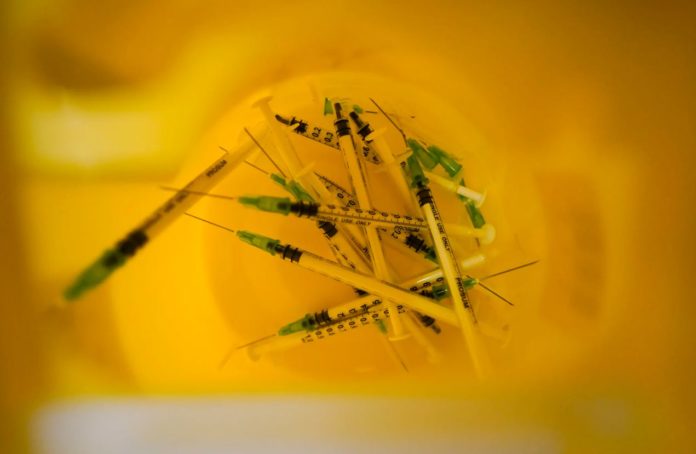Humanity has been drifting in a sea of COVID-19 for the last two years. Nations are now awaiting news on whether the Omicron strain of the coronavirus is merely another swell in that sea or a monstrous tsunami that will crash down with catastrophic effect.
Is this to be our new future, always frightened that some new mutation will obliterate whatever semblance of normalcy we’ve managed to reclaim? According to experts, only time and science will tell.
“We haven’t had anything that looks like normal yet,” says professor Lauren Ancel Meyers, director of the COVID-19 Modelling Consortium at the University of Texas at Austin.
Dealing with the continued volatility will demand quick responses. The world must remain vigilant for unusually large waves on the horizon and act swiftly — even if it means simply pressing the “pause” button.
“We might need to take a moment, limit travel and encourage mask-wearing until we know what we’re dealing with so we don’t let something that’s more contagious and deadly get out of control,” adds Meyers.
This wait could provide governments with time to prepare if the news is bad, and vaccine manufacturers with time to provide revised boosters that address the new strain.
To maintain public trust, transparency and openness will be required, just as South Africa did when it learned of the new variant’s emergence.
However, experts advise officials to proceed lightly and exercise caution.
“If there are too many false alarms, we run the risk people might stop thinking they should take the threat seriously,” says biostatistician Rachel Piltch-Loeb from the Harvard T. H. Chan School of Public Health.
COVID-19, experts anticipate, will eventually become predictable within specific limitations, similar to how influenza is today.
“We know when flu generally starts to spread, we have vaccines that are sometimes better and sometimes worse, but we know what we need to do to keep them current and keep deaths and hospitalisations low,” says Meyers.
COVID-19 is still years away from attaining a manageable condition.
For the time being, any “new normal” is questionable, according to Piltch-Loeb. “We can still be caught flat-footed by this virus.”
What could be next?
COVID-19 could take one of two paths to a predictable pattern. Both lead to the same place, but one includes significantly more pain and death.
The ideal case is that immunization protects so many people that the virus has fewer chances to develop.
President Biden stated last week during a news conference that the new normal should involve everyone receiving vaccine booster doses, reducing the number of exposed people.
“If the virus has nowhere to spread, it has no opportunity to mutate and cause new variants to emerge,” says David Souleles, director of the COVID-19 Response Team at the University of California, Irvine.
The other way permits the virus to wreak havoc on a largely unprotected human population, sickening and killing millions until enough people develop a natural immunity that there are few remaining to infect.
“Historically, that’s been how pandemics resolve. But there was a huge toll on the human population,” adds Deborah Fuller, a microbiologist and division chief for infectious diseases and translational medicine at the University of Washington School of Medicine in Seattle.
Approximately 55% of mankind is currently immunized, however coverage is patchy. Much of North America and Europe have been vaccinated, but the vast majority of Africa has not.
“We’re still looking at a multi-year horizon before we see an uptake of vaccines that’s necessary to stop new variants from coming,” says Piltch-Loeb.
In either case, the COVID-19-causing SARS-CoV-2 virus will continue to mutate and evolve.
“That’s just what viruses do,” says Fuller.
Finally, the pandemic will fade away when a sufficient number of people have developed immunity, either from prior illness or vaccination.
That is precisely what occurred during the 1918 influenza pandemic, though not before infecting one-third of the world’s population and killing at least 50 million people, according to Dr. Gregory Poland, director of the Mayo Clinic’s Vaccine Research Group.
“The reality for repertory viruses is they become endemic, with periodic epidemics,” he says.
It will be similar to dealing with cold and flu season now, according to Dr. Roger Shapiro, a Harvard Medical School professor of medicine who works in Botswana, southern Africa, where the Omicron variant was identified.
“We’re probably going to have COVID season in the United States, and throughout the world, for a long time to come,” he says. “I think it starts to get to the point where we can say, ‘This is manageable.’”
Manageable does not imply that it vanishes. Diseases almost never completely disappear; they recur in lesser forms or infect fewer persons. The threat remains, albeit at a lower level than during the initial outbreak.
The 1918 influenza virus — dubbed the H1N1 strain in the medical community — is still very much alive and well, albeit in a modified and less lethal form, according to Poland, editor-in-chief of the journal Vaccine.
“If you got a flu vaccine this year, one of the strains in the shot was for H1N1.”
There is reason to be optimistic. Although COVID-19 is far from predictable and confined, Dr. Rochelle Walensky, director of the Centers for Disease Control and Prevention, stated that our ability to fight has significantly improved.
“One thing has become clear over the last 20 months,” she said.
“We cannot predict the future, but we can be prepared for it.”
Image Credit: AP
You were reading: Is Omicron new ‘COVID normal’ a new variant every few months?
